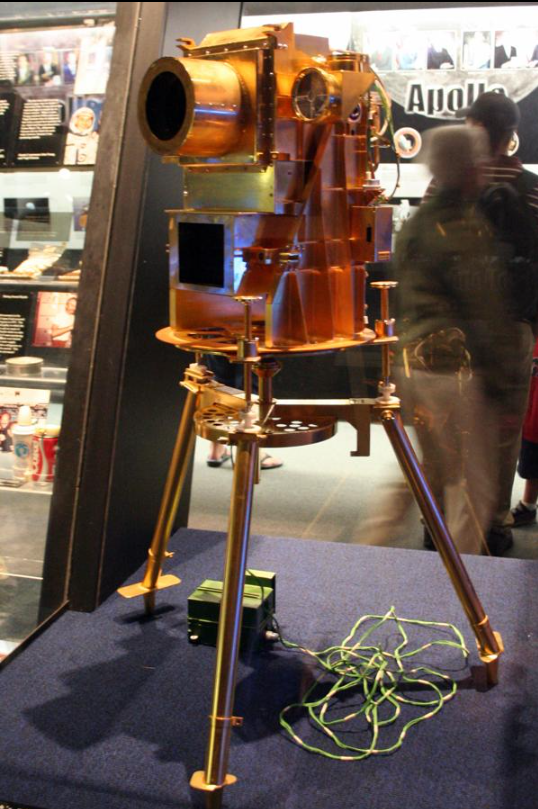
| Version | Summary | Created by | Modification | Content Size | Created at | Operation |
|---|---|---|---|---|---|---|
| 1 | Conner Chen | -- | 807 | 2022-11-11 01:15:30 | | | |
| 2 | Conner Chen | Meta information modification | 797 | 2022-11-15 04:38:52 | | |
Video Upload Options
1. Introduction
George Robert Carruthers (born October 1, 1939) is an award-winning African-American inventor, physicist, and space scientist. Carruthers invented the ultraviolet camera/spectograph for NASA to use when it launched Apollo 16 in 1972. His work also demonstrated that molecular hydrogen exists in the interstellar medium. In 2003, Carruthers was inducted into the National Inventor's Hall of Fame. He received an honorary doctorate for Engineering from Michigan Technological University.
2. Biography
Carruthers was born October 1, 1939, in Cincinnati, Ohio to George and Sophia Carruthers.[1][2] His father was a civil engineer and his mother was a homemaker and his family initially lived in Milford, Ohio. At an early age George developed an interest in physics, science and astronomy, which his father encouraged. At the age of 10 he built his first telescope out of cardboard tubing and lenses purchased using money he earned as a delivery boy.[1]
His father died when Carruthers was 12, and at that time his family moved to the South Side of Chicago where he stayed until he went to college.[3] He did not perform well in school at a young age, earning poor grades in math and physics. However, he won three separate science fair awards during this time.[1] Also as a child, he enjoyed visiting Chicago museums, libraries and the Adler Planetarium that caused him to be an avid science-fiction reader and enjoyed constructing model rockets. Later he became a member of the Chicago Rocket Society and various science clubs.[2]
After graduating from Englewood High School[2], he entered the College of Engineering at the University of Illinois, and received a Bachelor of Science degree in aeronautical engineering in 1961. Carruthers did his graduate work at the University of Illinois and earned Master's degree in nuclear engineering in 1962. Carruthers received a Ph.D. in aeronautical and astronomical engineering in 1964. While conducting his graduate studies, Carruthers worked as researcher and teaching assistant studying plasma and gases.[2]
During the 1980s, Carruthers helped create a program called the Science & Engineers Apprentice Program, which allows high school students to spend a summer working with scientists at the Naval Research Laboratory. Carruthers now works with NRL’s community outreach organization, and as such helps support several educational activities in the sciences in the Washington D.C. area.
Since 1983 he has been Chairman of the Editing and Review Committee and Editor, Journal of the National Technical Association.
During the summers of 1996 and 1997 he taught a course in Earth and Space Science for D.C. Public Schools Science teachers. He also helped develop a series of videotapes on Earth and Space science for high-school students.
Since 2002, Carruthers has been teaching a two-semester course in Earth and Space Science at Howard University sponsored by a NASA Aerospace Workforce Development Grant.
On February 12, 2009, Carruthers was honored as a Distinguished Lecturer at the Office of Naval Research for his achievements in the field of space science.
On February 1, 2013, Dr. Carruthers was awarded the 2012 National Medal of Technology and Innovation by President Barack Obama at the White House.[4]
He is a member of the American Astronomical Society, the American Geophysical Union, the American Institute of Aeronautics and Astronautics, the American Association for the Advancement of Science and the National Society of Black Physicists.
He has lived most of his life in Washington, DC.[5]
2.1. Inventions and Discoveries
Carruthers is considered the inventor of the ultraviolet camera/spectrograph.[1] His work with the spectrograph also demonstrated incontrovertible proof that molecular hydrogen exists in the interstellar medium.[6][7]

In 1964, Carruthers began employment for the U.S. Naval Research Laboratory in Washington, D.C., where his work focused on far ultraviolet astronomy.[2] 1969 was the year he received a patent for his invention, the "Image Converter," which detected electromagnetic radiation in short wavelengths,[2] and in 1970, he made the first examination of molecular hydrogen in space.
Two years later, Carruthers invented the first moon-based observatory, the Far Ultraviolet Camera/Spectrograph, which was used in the Apollo 16 mission.[2] In 1986, one of Carruthers' inventions captured an ultraviolet image of Halley's Comet. In 1991, he invented a camera that was used in the Space Shuttle Mission.
3. Awards
- Arthur S. Flemming Award (Washington Jaycees), 1970
- Exceptional Achievement Scientific Award Medal NASA 1972
- Black Engineer of the Year Award 1987[8]
- Warner Prize of the American Astronomical Society
- National Science Foundation Fellow
- Honorary Doctor of Engineering, Michigan Technological University
- Inducted into the National Inventor's Hall of Fame, 2003[9]
- National Medal of Technology and Innovation, 2012
References
- "George Carruthers" (in en-us). https://www.biography.com/people/george-carruthers-538794.
- "George Carruthers". Inventors. The Black Inventor On-Line Museum. 2011. http://www.blackinventor.com/pages/george-carruthers.html. Retrieved 13 November 2011.
- "George Carruthers" (in en). 2015-01-12. https://www.aip.org/history-programs/niels-bohr-library/oral-histories/32485.
- "NRL's Dr. George Carruthers Honored with National Medal of Technology and Innovation". http://www.nrl.navy.mil/media/news-releases/2013/dr-george-carruthers-honored-with-national-medal-of-technology-and-innovation. Retrieved 3 May 2013.
- Paul, Richard (June 15, 2009). "producer, "Race and the Space Race"". http://capecosmos.org.
- Loff, Sarah (2017-02-02). "Dr. George Carruthers and Apollo 16 Ultraviolet Camera/Spectrograph" (in en). NASA. https://www.nasa.gov/image-feature/looking-back-dr-george-carruthers-and-apollo-16-far-ultraviolet-cameraspectrograph.
- Alkalimat, Abdul (2004). The African American Experience in Cyberspace. Pluto Press. ISBN:0-7453-2222-0.
- "Carruthers, George (1939- ) | The Black Past: Remembered and Reclaimed" (in en). http://www.blackpast.org/aah/george-carruthers-1939.
- "11 African American Inventors Who Changed the World" (in en-US). https://www.msn.com/en-us/lifestyle/smart-living/11-african-american-inventors-who-changed-the-world/ss-BBIMZ3w#image=7.
.jpg/300px-Lunar_Surface_Ultraviolet_Camera_(9460222206).jpg)
Location: Cincinnati, Ohio




